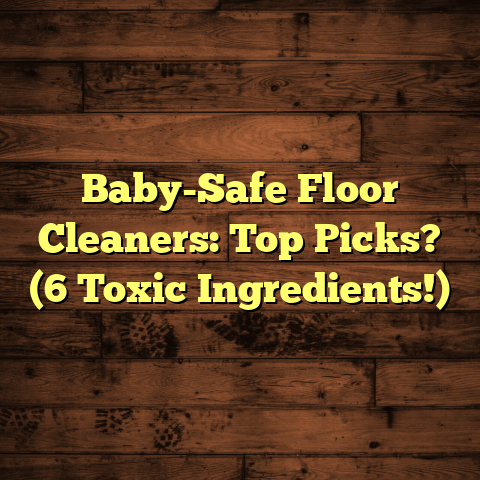How To Make My Stained Concrete Floors Shine? (Explained)
Stained concrete floors can transform a simple space into something beautiful and unique.
I remember the first time I walked into a home with polished stained concrete; it felt warm and inviting.
When I decided to stain my own concrete floors, I was thrilled by the prospect of achieving that same vibrant look.
However, maintaining that shine requires ongoing effort and knowledge.
In this guide, I will share my journey, including the steps I took, the challenges I faced, and the insights I gained along the way.
Understanding Stained Concrete
What is Stained Concrete?
Stained concrete involves applying a coloring agent to the surface of cured concrete.
This process enhances the visual appeal while preserving the concrete’s durability.
There are two primary types of stains: acid-based and water-based.
- Acid-Based Stains: These react chemically with the minerals in the concrete, creating rich, variegated hues.
They are often limited in color options but provide a deep natural look. - Water-Based Stains: These offer a broader range of colors and are easier to apply and clean up.
They do not penetrate as deeply as acid stains but provide a uniform appearance.
Why Choose Stained Concrete?
Stained concrete floors are becoming increasingly popular due to their aesthetic versatility and low maintenance requirements.
They can mimic the look of natural stone or wood without the associated costs and upkeep.
Additionally, stained concrete is durable, making it ideal for high-traffic areas.
My Journey to Shine
Initial Preparation: Setting the Stage
The first step in my journey was to prepare my concrete floors properly.
I should emphasize that proper preparation is crucial for achieving a long-lasting shine.
- Cleaning the Floor: I started by removing any furniture and rugs from the area.
Then, I swept thoroughly to eliminate dust and debris.
For stubborn stains, I used a mixture of warm water and a pH-neutral cleaner.
A stiff-bristle broom was essential for scrubbing away dirt that had settled into the surface. - Assessing the Surface: After cleaning, I inspected the floor for cracks or damage.
It’s important to address these issues before applying any stain or polish, as they can affect the final appearance. - Sanding (if necessary): In some areas, I found that light sanding helped smooth rough spots on the concrete surface.
For this, I used a floor sander with 120-grit sandpaper.
This process took about two hours for my 800-square-foot living room.
Cost of Initial Preparation: The cleaner cost around $30, and renting a floor sander was about $50 for a day.
Applying Stain: Choosing the Right Product
Once the floor was prepped, it was time to select a stain.
After much research, I opted for a water-based stain for its ease of use and vibrant color options.
Application Process
- Testing Colors: Before committing to a color, I tested several samples on small patches of concrete.
This step is crucial because colors can appear different once applied. - Gathering Supplies: For application, I assembled a few essential tools:
- A paint roller with an extension handle
- A paintbrush for edges
- A sprayer (if needed for large areas)
- Gloves and safety goggles
- Staining Technique: Using a roller, I began applying the stain in sections.
I started at one end of the room and worked my way out to avoid stepping on freshly stained areas.
The process required careful attention to ensure even coverage without drips or streaks.
Timeframe: The staining process took about four hours, including drying time between coats.
Cost: A gallon of water-based stain cost around $40 and covered approximately 300 square feet.
Sealing the Stained Concrete
After the stain dried completely (about 24 hours), sealing was next on my agenda.
Sealing protects the surface from stains and wear while enhancing the color’s vibrancy.
- Choosing a Sealant: I decided on a water-based acrylic sealer for its ease of application and low odor.
There are also solvent-based sealers that offer a harder finish but require more ventilation during application. - Application: Using a clean roller, I applied the sealer in thin coats.
It’s important to avoid overapplying, as this can lead to bubbling.
After applying the first coat, I allowed it to dry for 24 hours before adding a second coat.
Cost: A gallon of sealer cost around $60, covering about 400 square feet.
Challenges Faced During Application
While applying the stain and sealer went relatively smoothly, I encountered some challenges:
- Uneven Color Distribution: My first attempt resulted in uneven color patches due to inconsistent application techniques.
After some trial and error, I learned that rolling in one direction helped achieve a more uniform look. - Bubbles in Sealant: After sealing, I noticed small bubbles forming in some areas.
This happened because I applied too thick of a coat too quickly.
Allowing adequate drying time between coats resolved this issue for future applications.
Maintaining the Shine
Now that my stained concrete floors were completed, maintaining their shine became my priority.
Here’s what I found works best:
Regular Cleaning Routine
- Daily Maintenance: Sweeping or vacuuming daily helps keep dirt and debris from scratching the surface.
- Weekly Damp Mopping: Once a week, I used a damp mop with a pH-neutral cleaner specifically designed for sealed concrete floors.
Avoiding harsh chemicals was vital since they can dull the finish over time. - Spot Cleaning: For spills or stains, I quickly wiped them up with a clean cloth to prevent any lasting damage.
Reapplication of Polish
To maintain that glossy finish, reapplying polish every six months became part of my routine:
- Selecting Polish: After testing several brands, I found that Brand C (a hybrid polish) worked best for me due to its durability and ease of application.
- Application Method: Following the manufacturer’s instructions, I used a microfiber mop to apply the polish evenly across the floor in circular motions.
- Drying Time: Each coat required about two hours to dry before applying subsequent coats—usually two coats provided an optimal shine.
Troubleshooting Common Issues
Despite my best efforts, certain issues arose over time:
Dullness Over Time
Even with regular cleaning and polishing, some areas began to lose their shine after several months.
Here’s how I tackled it:
- Reassessment of Cleaning Products: I realized that using cleaners with harsh chemicals contributed to this issue.
Switching to milder products helped restore some luster. - Deep Cleaning: Every so often, I conducted a deep clean using a specialized concrete cleaner designed to lift built-up grime without damaging the surface.
Scratches from Furniture
Furniture placed on stained concrete can sometimes lead to scratches or scuffs:
- Furniture Pads: To prevent this issue from occurring again, I purchased felt pads for all furniture legs.
This simple addition significantly reduced scratches.
Comparative Analysis of Products Used
Here’s a closer look at some of the products I’ve used throughout this project:
In my experience, using Brand C polish provided the best results in terms of longevity and ease of use.
Practical Tips for Success
Based on my journey with stained concrete floors, here are some practical tips:
- Invest in Quality Products: While it might be tempting to go for cheaper options, investing in high-quality stains, sealers, and polishes pays off in durability and appearance.
- Stay Consistent with Maintenance: Establishing a regular cleaning schedule is key to preserving your floors’ beauty.
- Be Patient During Application: Take your time when applying stain and sealant; rushing can lead to mistakes that might require redoing sections.
- Test First: Always test stains and sealers in inconspicuous areas before full application to ensure you’re happy with the results.
- Keep an Eye on Humidity: High humidity can affect drying times and results when applying finishes; choose your application days wisely.
Conclusion
Maintaining stained concrete floors may seem daunting initially, but with proper preparation, regular maintenance, and quality products, achieving that stunning shine is entirely possible.
My journey has been filled with learning experiences—some frustrating moments turned into valuable lessons that ultimately led to beautiful results.
The transformation of my living space has only reaffirmed my love for stained concrete floors; they are not just visually appealing but also practical for day-to-day living.
By sharing my story and insights here, I hope you feel equipped and inspired to start your own journey toward achieving shiny stained concrete floors that enhance your home’s beauty for years to come!





